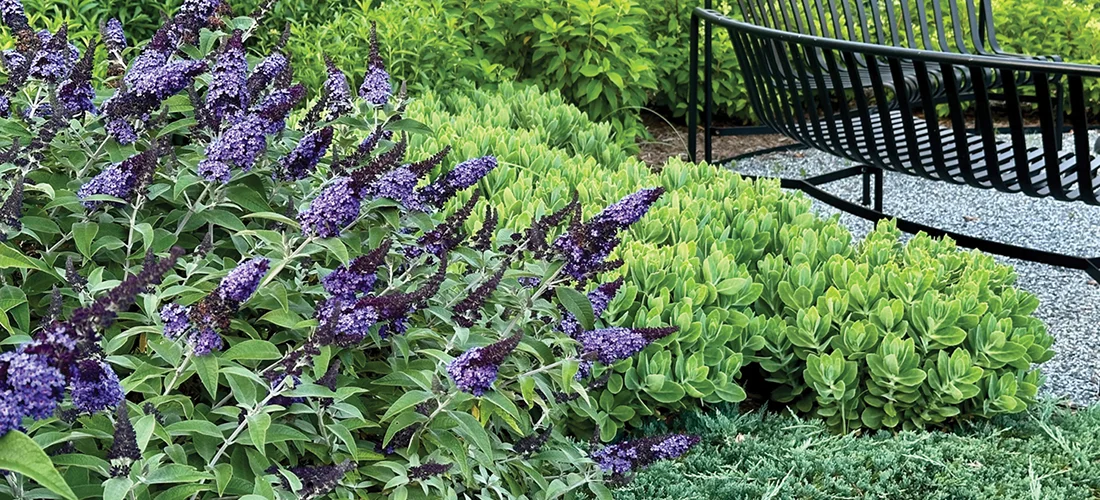Seize the clay
July 27, 2024

How to garden in sunny, dry spaces with clay soil
by Jay Sifford
Most gardeners dream of loose, loamy soil rich in nutrients, just the right amount of rain, and that magical mix of morning sun and afternoon shade. But when we awaken and are pulled back into reality, many of us garden in full sun and clay soil. Rather than fighting the battle with copious amounts of water, fertilizer and frustration, is it possible to adopt a strategy of embracing what we have and choosing plants appropriately?
First, let’s consider a bit of science. Clay soil has always been considered the bane of the Southern gardener’s existence. There are, however, reasons to embrace it. First, there are plants that naturally grow quite well in it. Think native maples, oaks and sweet gums, along with prairie plants with deep taproots such as switchgrass and baptisia. Second, clay is rich in nutrients such as potassium, iron and calcium, requiring less supplemental fertilizer. It also holds water more efficiently than looser soil. But because it’s so dense, air pockets — necessary for optimal plant performance — do not form. Additionally, clay is electrically charged to not release its rich nutrients for absorption by plants.


Panicle hydrangea and Coneflower
The solution is to amend the clay with compost or other organic matter. Doing so will loosen the soil so that air can travel to plant roots and will allow for better drainage. Organic matter coats the clay molecules to alter the electrical charge so that plants can access those nutrients. (Do not, however, add sand to your clay soil, lest you end up with something that resembles concrete.) Amended clay soil is truly something that we Southerners can embrace.
Now that we’ve embraced and amended our clay, let’s look at three groups of plants that are both beautiful and somewhat water-wise after they are established.
First, suitable Mediterranean/eastern European and South African plants are those that naturally grow in thin, lean and rocky soil, have shallow root systems, and thrive in an abundance of direct sunlight. They require little water after establishment, making them perfect choices for the water-wise sunny garden. Mixing some small drainage gravel into amended clay soil will help these plants thrive, as will planting them on a slope or berm. An abundance of water, particularly in winter, will likely cause root or crown rot. An added bonus is that many of these plants have an herbal fragrance to the foliage. This discourages grazing by deer.


Russian sage and ‘Cassian’ pennisetum (fountain grass)
Easily sourced plants in this group include rosemary, lavender (‘Phenomenal’ is a cultivar grown for our heat and humidity), many salvias, dianthus, thyme, Russian sage, short verbenas, catmint, Kniphofia (red hot pokers), sedums and ice plant.
Next, many prairie and meadow plants establish deep root systems that search for water when the surface moisture is depleted. Suitable plants from this group that will thrive in our area include coneflowers, black-eyed Susans, baptisia and asters. Many of the ornamental grasses are included in this group, including switchgrass (Panicum) and fountain grass (Pennisetum). Incorporating groups of these grasses in your planting scheme adds invaluable texture and kinetic movement to your garden.
Finally, shrubs worth noting include junipers with colorful and textural foliage such as ‘Grey Owl,’ ‘Lime Glow’ and ‘All Gold.’ Blooming shrubs include weigela, bluebeard (Caryopteris), dwarf butterfly bushes (‘Pugster’ series buddleia), cotoneaster, lantana and the sun-loving panicle hydrangeas. Horticulturists will tell you that more hydrangeas are killed by over-watering than by under-watering.
As summers become hotter and water becomes more precious, why not incorporate some of these plants into your garden? SP
Featured Image: ‘Pugster’ dwarf butterfly bush with sedum and Blue Rug juniper. Photographs courtesy of landscape designer Jay Sifford.
